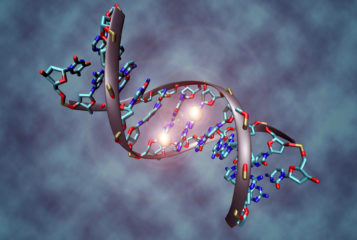A DNA blood test for children aged five can help predict body fat levels when they are aged 9 to 14, a small study suggests.
Scientists measured levels of a kind of chemical modification of DNA called methylation on the PCG1 gene that regulates fat metabolism. In the study of 40 children, a ten percent increase in levels of DNA methylation at age five was linked with having up to 12 percent more body fat at age 14.
Methylation is an 'epigenetic switch' that can control gene activity by switching off certain genes. DNA methylation patterns change in response to environmental factors such as diet or air pollution, but in some parts of the genome, methylation patterns established in early childhood remain stable for years.
In this study, methylation of PCG1 remained constant over time so this blood test marker may help identify children who would benefit from early intervention against obesity.
Dr Graham Burdge from the University of Southampton, senior author of the study, said: 'It can be difficult to predict when children are very young which children will put on weight or become obese. It is important to know which children are at risk, because help, such as suggestions about their diet, can be offered early and before they start to gain weight'.
Currently almost a third of 10- to 11-year-olds in England and over a fifth of four- and five-year-olds are overweight or obese. Most obese children remain obese into adulthood, which raises their risk of health conditions such as type 2 diabetes, heart disease and cancer.
In the study, published in the journal Diabetes, researchers measured methylation at seven sites in the PCG1 gene that tend to be methylated in overweight adults with diabetes. At four of these sites there was an association between DNA methylation at age five and future body fat levels, independent of a child's age, gender, timing of puberty and levels of physical activity.
However, the study could not establish whether DNA methylation was itself responsible for any increase in body fat. The researchers note that differences in levels of fat might be due to diet or to other environmental or genetic factors.
Dr Burdge said that the findings 'need to be tested in larger groups of children' but the study nonetheless provides 'evidence that being overweight or obese in childhood is not just due to lifestyle but may also involve basic processes that control our genes'.
Nonetheless, a predictive test for obesity based on the information in this study is unlikely to be commercially available soon.
Sources and References
-
Peroxisomal proliferator activated receptor-γ-co-activator-1α promoter methylation in blood at 5—7 years predicts adiposity from 9 to 14 years (EarlyBird 50)
-
Blood test may help predict whether a child will become obese
-
Simple blood test may predict if a child will become obese
-
The new blood test for children that can tell if they are going to be obese - by the time they are teenagers
-
Heading off the obesity epidemic: DNA tests at five can tell if a child will be fat at 14
-
Blood test can predict whether a child will be obese
-
Could a DNA test predict obesity risk in children?






Leave a Reply
You must be logged in to post a comment.